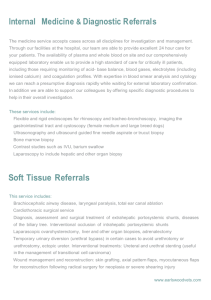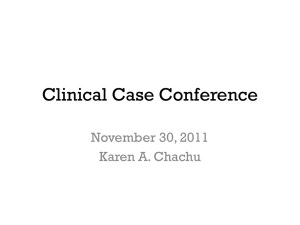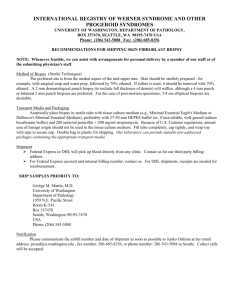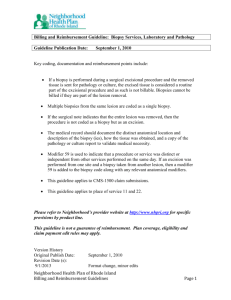Short Course 4 Short Course in honor of Christoph E. Hedinger
advertisement
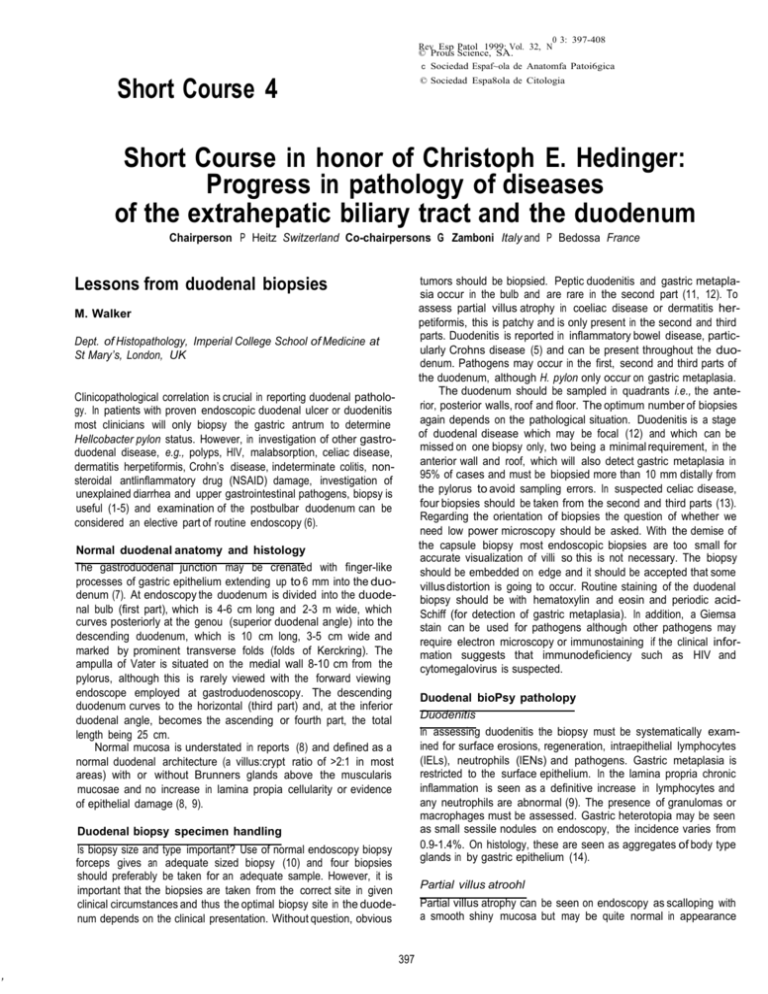
’ 0 3: 397-408 Rev Esp Patol 1999; Vol. 32, N © Prous Science, SA. c Sociedad Espaf~ola de Anatomfa Patoi6gica © Sociedad Espa8ola de Citologia Short Course 4 Short Course in honor of Christoph E. Hedinger: Progress in pathology of diseases of the extrahepatic biliary tract and the duodenum Chairperson P Heitz Switzerland Co-chairpersons G Zamboni Italy and P Bedossa France tumors should be biopsied. Peptic duodenitis and gastric metaplasia occur in the bulb and are rare in the second part (11, 12). To assess partial villus atrophy in coeliac disease or dermatitis herpetiformis, this is patchy and is only present in the second and third parts. Duodenitis is reported in inflammatory bowel disease, particularly Crohns disease (5) and can be present throughout the duodenum. Pathogens may occur in the first, second and third parts of the duodenum, although H. pylon only occur on gastric metaplasia. The duodenum should be sampled in quadrants i.e., the anterior, posterior walls, roof and floor. The optimum number of biopsies again depends on the pathological situation. Duodenitis is a stage of duodenal disease which may be focal (12) and which can be missed on one biopsy only, two being a minimal requirement, in the anterior wall and roof, which will also detect gastric metaplasia in 95% of cases and must be biopsied more than 10 mm distally from the pylorus to avoid sampling errors. In suspected celiac disease, four biopsies should be taken from the second and third parts (13). Regarding the orientation of biopsies the question of whether we need low power microscopy should be asked. With the demise of the capsule biopsy most endoscopic biopsies are too small for accurate visualization of villi so this is not necessary. The biopsy should be embedded on edge and it should be accepted that some villus distortion is going to occur. Routine staining of the duodenal biopsy should be with hematoxylin and eosin and periodic acidSchiff (for detection of gastric metaplasia). In addition, a Giemsa stain can be used for pathogens although other pathogens may require electron microscopy or immunostaining if the clinical information suggests that immunodeficiency such as HIV and cytomegalovirus is suspected. Lessons from duodenal biopsies M. Walker Dept. of Histopathology, Imperial College School of Medicine at St Mary’s, London, UK Clinicopathological correlation is crucial in reporting duodenal pathology. In patients with proven endoscopic duodenal ulcer or duodenitis most clinicians will only biopsy the gastric antrum to determine Hellcobacter pylon status. However, in investigation of other gastroduodenal disease, e.g., polyps, HIV, malabsorption, celiac disease, dermatitis herpetiformis, Crohn’s disease, indeterminate colitis, nonsteroidal antlinflammatory drug (NSAID) damage, investigation of unexplained diarrhea and upper gastrointestinal pathogens, biopsy is useful (1-5) and examination of the postbulbar duodenum can be considered an elective part of routine endoscopy (6). Normal duodenal anatomy and histology The gastroduodenal junction may be crenated with finger-like processes of gastric epithelium extending up to 6 mm into the duodenum (7). At endoscopy the duodenum is divided into the duodenal bulb (first part), which is 4-6 cm long and 2-3 m wide, which curves posteriorly at the genou (superior duodenal angle) into the descending duodenum, which is 10 cm long, 3-5 cm wide and marked by prominent transverse folds (folds of Kerckring). The ampulla of Vater is situated on the medial wall 8-10 cm from the pylorus, although this is rarely viewed with the forward viewing endoscope employed at gastroduodenoscopy. The descending duodenum curves to the horizontal (third part) and, at the inferior duodenal angle, becomes the ascending or fourth part, the total length being 25 cm. Normal mucosa is understated in reports (8) and defined as a normal duodenal architecture (a villus:crypt ratio of >2:1 in most areas) with or without Brunners glands above the muscularis mucosae and no increase in lamina propia cellularity or evidence of epithelial damage (8, 9). Duodenal bioPsy patholopy Duodenitis In assessing duodenitis the biopsy must be systematically examined for surface erosions, regeneration, intraepithelial lymphocytes (IELs), neutrophils (lENs) and pathogens. Gastric metaplasia is restricted to the surface epithelium. In the lamina propria chronic inflammation is seen as a definitive increase in lymphocytes and any neutrophils are abnormal (9). The presence of granulomas or macrophages must be assessed. Gastric heterotopia may be seen as small sessile nodules on endoscopy, the incidence varies from 0.9-1.4%. On histology, these are seen as aggregates of body type glands in by gastric epithelium (14). Duodenal biopsy specimen handling Is biopsy size and type important? Use of normal endoscopy biopsy forceps gives an adequate sized biopsy (10) and four biopsies should preferably be taken for an adequate sample. However, it is important that the biopsies are taken from the correct site in given clinical circumstances and thus the optimal biopsy site in the duodenum depends on the clinical presentation. Without question, obvious Partial villus atroohl Partial villus atrophy can be seen on endoscopy as scalloping with a smooth shiny mucosa but may be quite normal in appearance 397 : SHORT COURSE 4 REV (15). Biopsy of established villus atrophy is easily recognized but more subtle early changes can be difficult to diagnose with confidence. There is a wide variation in villus height and age has no effect on morphometry (16). The normal villus height:crypt depth ratio is 3:5 and the surface enterocyte height is normally 29-34 pm. Crypt hyperplasia is a pointer and counting of intraepithelial lymphocytes is paramount. The normal range is 10-30/1 00 enterocytes (13). Differential diagnoses of celiac disease include infective enteropathy, tropical sprue, graft versus host and transient food sensitivities (eggs, fish, Soya, etc.), immunoproliferative disease and drug damage. Duodenal pathology in partial villus atrophy associated with dermatitis herpetiformis is identical to celiac disease. Celiac disease is a clinicopathological diagnosis with a characteristic lesion of the small intestine, malabsorption and prompt improvement on a gluten-free diet. Symptoms are related to the extent of mucosa involved. Antigliadin antibody screening tests are useful in at risk groups but biopsy is the gold standard for diagnosis (17). ESP PATOL 5. DInca R, Sturniolo 0, Cassaro M et al. Prevalence of upper gastrointestinal lesions and Helicobacterpylon infection in Crohns disease. Dig Dis Sd 199S; 43: 988-992. 6. Morales TO, delta PE, Fennerty MB et al. Yield of routine endoscopy beyond the duodenal bulb. d Olin Gastroenterol 1997; 24: 147-149. 7. Lawson HH, Definition of gastroduodenal junction in healthy subjects. d Olin Path 1988; 41: 393-396. 8. Jenkins D, Goodall A, QuIet FR at al. Defining duodenitis: Quantitative histological studyof mucosal responses and their correlations. J Olin Pathol 1985; 38: 1119-1126. 9. Wyatt dl, Rathbone BJ, Sobala GM at al. Gastric epithelium in the duodenum: Its association with Helicobacter pylon and inflammation. J Olin Pathol 1990; 43: 981-986. 10. Ladas SD, Tsamouri M, Kouvidou 0 et al. Effect of forceps size and mode of Orientation on endoscopic small bowel evaluation. Gastrointest Endosc 1994; 40: 51-54. 11. Leonard N, Feighery OF, Hourihane DO. Peptic duodenitis-does it exist in the second part of the duodenum?d Olin Pathol 1997; 50: 54-58. 12. Walker MM, Dixon MF. Gastric metaplasia: Its role in duodenal ulceration, Ailment Pharmacol Ther 1996; l0(Suppi. 1): 119-128. 13. Shidrawi RG, Przemioslo R, Davies DR et al. Pitfalls in diagnosing coeliac disease. J Olin Pathol 1994; 47: 693-694. 14. Johansen A, Hart Hansen 0. Heterotopic gastric epithelium in the duodenum andits correlation to gastdc disease and acid level. Ada Path Microbiol Scand 1973; 81: 676-680. 15. Dickey W. Diagnosis of coeliac disease at open-access endoscopy. Scand J Gastroenterol 1998; 33: 61 2-615. 16. Lipski PS, Bennel MK, Kelly Pd at al. Again9 and duodenal morphometry. J Olin Pathol 1992; 45: 450-452. 17. Trier dS. Diagnosis of celiac sprue. Gastroenterology 1998; 115: 211-21 6. 18. Oberhuber 0, Kastner N, Stolte M. Giardiasis: A histologic analysis of 567 cases. Scand .1 Gastroentarol 1997; 32: 48-51. 19. Durand DV, Lecomte 0, Oathebras P at al. Whipple disease. Clinical review of 52 cases. Medicine (Baltimore) 1997; 76: 170-184. Pathogens Numerous microorganisms infect duodenal mucosa, particularly in immunosuppressed patients and may be either asymptomatic or symptomatic, leading to endoscopy and biopsy. Principal pathogens are cytomegalovirus, microsporidiosis, cryptosporidiosis in immunosuppression, in which a high index of suspicion is needed for diagnosis, as the changes are subtle. Giardia lamb/ia infection also shows nonspecific pathological changes (18). Whipples disease is a rare multisystem bacterial infection with characteristic duodenal pathology. The organism is Tropheryma whippelli. The diagnosis is usually established by duodenal biopsy but the gut is not inevitably involved (19). SugQested reporting orotocol for duodenum Systematically note: Site (+1— Brunners glands)? Dl, D2 Villus architecture — normal/distorted Surface — erosion, IELs, lENs, gastric metaplasia — ±1—extent? Inflammation, active and/or chronic, grade mild, moderate, severeepithelium/lamina propria Pathogens Other pathologies (e.g., granulomas, macrophages)? Tumors of the amputla: Pathogenesis and prognostic factors G. Zamboni and A. Scarpa Institute of Pathological Anatomy University of Verona, Italy This gives the algorithm Depending on biopsy site: Dl — Active duodenitis, lENs + gastric metaplasia + antral H. pylon = DU risk D2 — Definite villus distortion, no neutrophils, $IELs = partial viius atrophy D1/2 — Chronic duodenitis — think of other pathology e.g., pathogens, IBD, etc. Ampullary epithelial neoplasms include benign (5%) and malignant tumors (95%), which represent 5% of all gastrointestinal tumors but which account for up to 36% of the surgically operable pancreaticoduodenal tumors (1). Ampullary carcinoma is a tumor topographically centered in the region of the ampulla of Vater, which is formed by three anatomical components: the ampulla (common channel), the intraduodenal portion of the bile duct and the intraduodenal portion of the pancreatic duct. Thus, it may show infestinal or pancreatobiliary morphology. The unequivocal establishment of ampullary origin is possible in small lesions by applying strict topographical criteria obtained at gross and histological examination. The presence of ‘preinvasive” (adenomas or areas of dysplasia) modification in the anatomical structures of the ampulla (2) and the intestinal type of the carcinoma can help in the distinction (3). Periampullary carcinoma, is a widely used term to define a heterogeneous group of neoplasms arising from the head of the pancreas, the terminal common bile duct and the duodenum. The din- References 1. Sires W. Duodenitis: A clinical, endoscopic and histopathological study 0 d Med 1985; 56: 593-600. 2. Matsui K, Kitagawa M. Biopsy study of polyps in the duodenal bulb. Am d Gaslroenterol 1993; 88: 253-257. 3. Bown JW, Savides TJ, Mathews 0 at al. Diagnostic yield of duodenal biopsy and aspirate in AIDS-associated diarrhoea. Am J Gastroenlerol 1996; 91: 2289-2292. 4. darters MD, Hourihane D OB. Coeliac disease with histological features of peptic duodenitis: Value of assessment of intraepithelial lymphocytes. J Olin Pathol 1993; 46: 420-424. 398


